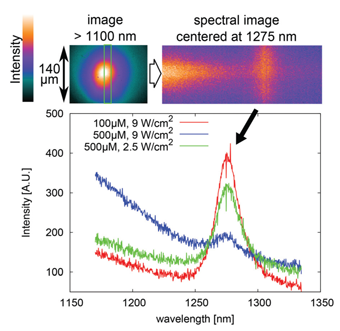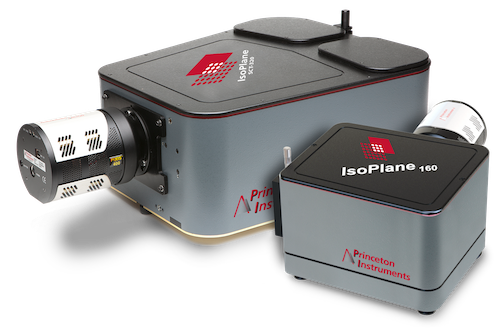Singlet Oxygen Imaging
Molecular oxygen is one of the most important molecules in maintaining and extinguishing life as well as destroying materials. For several decades, researchers have been intrigued by the physical and chemical properties of molecular oxygen’s lowest excited state, singlet oxygen (1O2). Singlet oxygen has a unique reactivity that can result in polymer degradation or the death of biological cells. Its role as an intermediate in cell death is exploited by photodynamic therapy (PDT) for cancer, a technique in which light is utilized as a medical tool.
In PDT, a photosensitizer is incorporated into abnormal tissues and then irradiated with visible light so that it transfers energy to ground-state oxygen via the type II photochemical pathway, producing singlet oxygen (detected by its weak 1270 nm emission). Several high-spatial-resolution methods have been proposed to detect 1O2 luminescence using either a single photomultiplier tube (PMT), a linear InGaAs detector array, or a two-dimensional InGaAs detector.

Cameras for Singlet Oxygen Imaging
NIRvana Family
Singlet oxygen imaging emits at 1270 nm and is therefore within the NIR wavelength range, which necessitates an InGaAs camera. The NIRvana family of cameras achieves high sensitivity within 900-1700 nm range through the use of focal plane array InGaAs sensors.
Imaging of singlet 1O2 relies on sensitive cameras with low noise to detect the weak emission signal. The NIRvana is thermoelectrically cooled, with temperatures reaching as low as -85℃, providing the lowest level of dark noise for low-light imaging. The cryogenically cooled NIRvana LN camera is also available, reaching temperatures of -190℃.
With high signal-to-noise ratios up to 250 full frames per second, the NIRvana family of cameras allows for fast capture of 1O2 emission even with extremely low exposure times.


PI-MAX4
Although direct emission of 1O2 occurs at 1270 nm, indirect imaging can also be achieved. When two singlet oxygen molecules collide they fluorescence at 634 and 703 nm. The PI-MAX offers high quantum efficiency for emission in the wavelength region of 200 – 900 nm. With high precision timing and sensitivity, the ICCD sensor can capture the red glow of simultaneous 1O2 emission.
The coupling of the EMCCD to an image intensifier allows for a 6x higher light throughput between the image intensifier and the detector in comparison to lens-coupled configurations. This ensures detection of 1O2, even though the emission is weak.
Spectrometers for Singlet Oxygen Imaging
IsoPlane
The guarantee of weak singlet oxygen signal capture is possible due to the high spectral resolution and imaging performance offered by the IsoPlane.
The IsoPlane provides twice the light-gathering power of a typical Czerny-Turner spectrograph, something required for low-light spectroscopy. This produces sharper images and improved resolution, ensuring all peaks within the resulting spectra are distinguished without the need for post-processing techniques.
The IsoPlane is astigmatism-free giving high spatial resolution, preventing crosstalk between >100 optical fiber channels, important if experimental set-ups are using fiber bundles for light capture.

